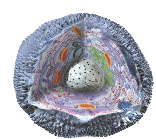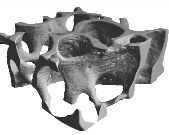Glass Science

Bioactive glasses were initially concieved in the late 1960`s and have generated considerable interest as a medical material ever since. This class of materials is generally characterized as having a low SiO2 content (60wt%) and a relatively high concentration of network modifiers (Na, Ca). These features encourage the dissolution of the glass surface in vivo which promotes ion release and the subsequent therapeutic effect, which includes a stable long term bond to bone tissue.
Medical Materials

Bone cements have traditionally been used to stabilize metallic implants in the human body. Some common examples include Total Hip Arthroplasty and Total Knee Arthroplasty where the metallic component of the implant is secured to bone with use of cementation. More recently spinal procedures such as Vertebroplasty and Kyphoplasty have employed cementation to correct and stabilize vertebral compression fractures as these materials can be injected through the skin into the spine using minimally invasive techniques.
Ceramic Engineering
Glass/ceramic scaffolds have generated interest as bone substitutes due to their ability to encourage the migration and proliferation of host cells within damaged regions of bone. These scaffolds can provide a framework where our own host cells can aid in the regeneration of new healthy tissue by providing a three dimensional construct where soft tissues and blood vessels can grow within the porous structure. These materials are generally used as non-load bearing material which have specific pore sizes which can facilitate cell migration and proliferation.
Surface Science

Inorganic/organic or ionic coating on glass surfaces can be utilized to prevent the growth of harmful microbes such as pathogenic bacteria and fungi. Coating are beneficial where difficulties arise in producing glasses that have anitbacterial properties. Thin films and coating can be achieved through spin or dip coating and greatly increases the versitility of glass surfaces.
Material Structure

The development of novel bioactive glasses and ceramics requires in depth characterization to understand any changes in the materials structure at the atomic level. Techniques such as x-ray diffraction, x-ray photoelectron spectroscopy and Raman spectroscopy are essential to understanding materials atomic structure, the presence or absence of crystal structures and atomic coordination.
Microbiology

The primary goal of developing biomaterials is to aid and repair tissues that are in a damaged or diseased state. Cell culture techniques can be used to determine cell viability when exposed to novel materials and to quantifiy based on cell survivability. The cells utilized for this testing include fibroblasts, cancer cells and osteoblasts. Antimicrobial materials can prevent the proliferation of microbes post-implantation, including harmful microbes such as S. aureus.
